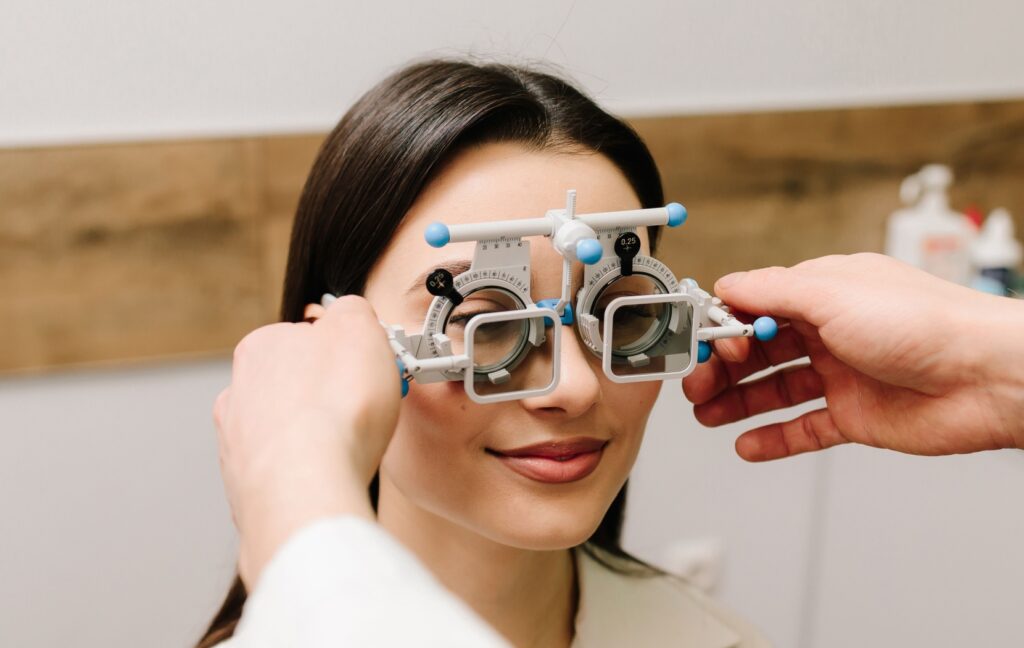If you wear glasses, you know that there’s more to eyeglasses than picking the most stylish frames. Maybe you’ve wondered about the science behind those lenses that help you see clearly. Understanding how eyeglasses work can help you make informed decisions about your eye care and appreciate the remarkable technology that improves millions of lives daily.
Eyeglasses correct vision problems by adjusting how light enters your eyes. When your eyes can’t focus light properly on the retina, glasses use specially curved lenses to redirect that light, creating clear, sharp vision. This simple yet sophisticated process has been helping people see better for hundreds of years.
How Do Your Eyes Focus Light?
Your eyes work much like a camera, using multiple components to create clear images. Light enters through the cornea, passes through the pupil, and is further focused by the lens inside your eye. When everything functions perfectly, this light converges precisely on the retina at the back of your eye, where it’s converted into electrical signals your brain interprets as vision.
The cornea provides about 65-75% of your eye’s focusing power, while the lens fine-tunes the focus for objects at different distances. This natural focusing system allows you to see clearly at various ranges, from reading a book to spotting a distant sign.
However, when the shape of your eye or the curvature of your cornea isn’t quite right, light doesn’t focus where it should. This creates blurry vision that glasses can correct.
Common Vision Problems & Their Causes
Nearsightedness (Myopia)
Nearsightedness occurs when your eyeball is too long or your cornea is too curved. Light focuses in front of the retina instead of directly on it, making distant objects appear blurry while close objects remain clear. This condition affects approximately 42% of Americans and often develops during childhood or adolescence.
Farsightedness (Hyperopia)
The opposite of nearsightedness, farsightedness happens when your eyeball is too short or your cornea isn’t curved enough. Light would theoretically focus behind the retina, causing nearby objects to appear blurry. People with mild farsightedness might see clearly at a distance but struggle with close-up tasks like reading.
Astigmatism
Astigmatism results from an irregularly shaped cornea or lens. Instead of being perfectly round like a basketball, the cornea may be shaped more like a football, with different curves in different directions. This causes light to focus at multiple points, creating blurred or distorted vision at all distances.
Presbyopia
As you age, the lens in your eye becomes less flexible, making it difficult to focus on close objects. This natural aging process, called presbyopia, typically becomes noticeable around age 40. Many people first notice it when they need to hold reading material farther away to see it clearly.

How Corrective Lenses Fix Vision Problems
Eyeglasses work by adding precisely calculated focusing power to your eye’s natural optical system. The lenses are ground to specific curvatures that compensate for your eye’s focusing errors.
Correcting Nearsightedness
Concave lenses, which are thinner in the center and thicker at the edges, correct nearsightedness. These lenses diverge light rays slightly before they enter your eye, moving the focal point backward to land directly on the retina. The stronger the prescription, the more concave the lens needs to be.
Correcting Farsightedness
Convex lenses, thicker in the center and thinner at the edges, correct farsightedness. These lenses converge light rays before they enter your eye, moving the focal point forward onto the retina. This helps your eye focus on nearby objects without strain.
Correcting Astigmatism
Cylindrical lenses correct astigmatism by having different powers in different meridians. These lenses are curved more in one direction than another, counteracting the irregular shape of the cornea or lens. The prescription includes an axis measurement that indicates the orientation of the correction.
Addressing Presbyopia
Presbyopia requires special consideration since it affects near vision while distance vision may remain clear. Bifocal lenses contain two different prescriptions in one lens, with the upper portion for distance and the lower portion for reading. Progressive lenses offer a more gradual transition between multiple focal points, providing clear vision at all distances without visible lines.
How Do I Know if I Need Eyeglasses?
Recognizing the signs of potential vision problems is essential to maintaining good eye health. You may need an eyeglasses prescription if you experience any of the following:
- Frequent headaches, especially after reading or using a computer.
- Difficulty focusing on objects either up close or far away.
- Squinting to see clearly or improve focus.
- Holding books, phones, or other objects unusually close or far from your eyes.
- Seeing halos or glare appear around lights, especially at night.
- Eye strain or discomfort during or after prolonged visual tasks.
- Experiencing double vision or blurry vision in one or both eyes.
If you notice one or more of these signs, scheduling a comprehensive eye exam with a qualified optometrist or ophthalmologist is recommended. Early intervention can address vision problems and support eye health effectively.
Protecting Your Vision for Life
Regular eye exams remain the best way to maintain healthy vision and catch problems early. Even if you don’t currently wear glasses, comprehensive eye exams can detect conditions like glaucoma, diabetic retinopathy, or macular degeneration before they cause noticeable symptoms.
If you’re experiencing any kind of vision problems or haven’t had an eye exam recently, consider scheduling an appointment with Total Vision Campbell. Their experienced team can provide comprehensive eye care and help you achieve the clearest, most comfortable vision possible. Don’t let unclear vision impact your daily life when effective solutions are readily available.



